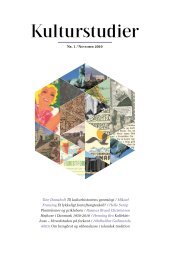Læs hele tidsskriftet (PDF) - Kulturstudier
Læs hele tidsskriftet (PDF) - Kulturstudier
Læs hele tidsskriftet (PDF) - Kulturstudier
Create successful ePaper yourself
Turn your PDF publications into a flip-book with our unique Google optimized e-Paper software.
<strong>Kulturstudier</strong> Nr. 2, 2011 The reconfigured body 9/15<br />
human and animal cells together. It was also necessary to dissolve the boundaries<br />
separating human and animal.<br />
The company PPL Therapeutics succeeded in cloning a pig on March 5, 2000.<br />
The clones were named Christa, (after Christan Barnard who carried out the first<br />
human to human heart transplantation in 1967), Alexis and Carrel, (after Alexis<br />
Carrel who received the Nobel Prize in 1912 for his transplantation research),<br />
and Millie and Dotcom. Millie and Dotcom were symbolic names that related to<br />
the economic growth of the Internet companies at the beginning of the new millennium.<br />
The names can be seen as a form of popularization where the biotechnological<br />
knowledge was translated into something concrete that investors could<br />
relate to. 27 However, the cloned pig did not become a success. At the beginning<br />
of the year 2000 most countries that had continued with xenotransplantation research,<br />
had also introduced a moratorium for clinical and experimental trials on<br />
humans. In Sweden the moratorium fragmented the research groups. At the same<br />
time stem cell research came as a new and promising biotechnological research<br />
that was said to solve the same medical problems as xenotransplantation. By the<br />
millennium stem cell researchers had captured the investors’ interest.<br />
Dangerous actors<br />
In the middle of the 1990s, new scientific findings emerged, drawing attention to<br />
the fact that cells, tissue and organs from animals contain retrovirus that could<br />
infect the transplanted patient. They in their turn could infect others and in<br />
worst-case scenario, start a global epidemic. In the countries performing or planning<br />
medical trials at the time, a moratorium was introduced in anticipation of<br />
new regulations. Many countries also started policy processes concerning calling<br />
off the moratorium and continuing with clinical trials in xenotransplantation.<br />
But when the policy processes had almost concluded by the end of the 1990s and<br />
beginning of the 2000s, the interest in xenotransplantation was weak. 28 In Sweden<br />
the moratorium came about in 1997 as an agreement among the researchers. 29<br />
As such it led to a difficult time for the Swedish researchers, and no official or<br />
publicized transplantations with animal organs have been carried out since the<br />
1990s. 30<br />
27 Hansson 2005.<br />
28 Brown and Beynon-Jones 2010.<br />
29 Hansson and Lundin 2011.<br />
30 However since the moratorium, there have been xenotransplantations with cells and tissue in different<br />
parts of the world (Brown and Beynon-Jones 2010; Persson and Welin 2008).<br />
150
















